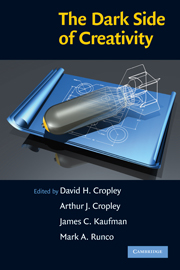Book contents
- Frontmatter
- Contents
- List of Contributors
- 1 The Dark Side of Creativity: What Is It?
- 2 Creativity Has No Dark Side
- 3 Positive Creativity and Negative Creativity (and Unintended Consequences)
- 4 Subjugating the Creative Mind: The Soviet Biological Weapons Program and the Role of the State
- 5 Imagining the Bomb: Robert Oppenheimer, Nuclear Weapons, and the Assimilation of Technological Innovation
- 6 The Innovation Dilemma: Some Risks of Creativity in Strategic Agency
- 7 Early Creativity as a Constraint on Future Achievement
- 8 Boundless Creativity
- 9 Reviewing the Art of Crime: What, If Anything, Do Criminals and Artists/Designers Have in Common?
- 10 Creativity in Confinement
- 11 Creativity and Crime: How Criminals Use Creativity to Succeed
- 12 So You Want to Become a Creative Genius? You Must Be Crazy!
- 13 Both Sides of the Coin? Personality, Deviance, and Creative Behavior
- 14 Neurosis: The Dark Side of Emotional Creativity
- 15 Dangling from a Tassel on the Fabric of Socially Constructed Reality: Reflections on the Creative Writing Process
- 16 Creativity in the Classroom: The Dark Side
- 17 The Dark Side of Creativity and How to Combat It
- 18 A Systems Engineering Approach to Counterterrorism
- 19 Malevolent Innovation: Opposing the Dark Side of Creativity
- 20 Summary – The Dark Side of Creativity: A Differentiated Model
- Index
- References
15 - Dangling from a Tassel on the Fabric of Socially Constructed Reality: Reflections on the Creative Writing Process
Published online by Cambridge University Press: 05 June 2012
- Frontmatter
- Contents
- List of Contributors
- 1 The Dark Side of Creativity: What Is It?
- 2 Creativity Has No Dark Side
- 3 Positive Creativity and Negative Creativity (and Unintended Consequences)
- 4 Subjugating the Creative Mind: The Soviet Biological Weapons Program and the Role of the State
- 5 Imagining the Bomb: Robert Oppenheimer, Nuclear Weapons, and the Assimilation of Technological Innovation
- 6 The Innovation Dilemma: Some Risks of Creativity in Strategic Agency
- 7 Early Creativity as a Constraint on Future Achievement
- 8 Boundless Creativity
- 9 Reviewing the Art of Crime: What, If Anything, Do Criminals and Artists/Designers Have in Common?
- 10 Creativity in Confinement
- 11 Creativity and Crime: How Criminals Use Creativity to Succeed
- 12 So You Want to Become a Creative Genius? You Must Be Crazy!
- 13 Both Sides of the Coin? Personality, Deviance, and Creative Behavior
- 14 Neurosis: The Dark Side of Emotional Creativity
- 15 Dangling from a Tassel on the Fabric of Socially Constructed Reality: Reflections on the Creative Writing Process
- 16 Creativity in the Classroom: The Dark Side
- 17 The Dark Side of Creativity and How to Combat It
- 18 A Systems Engineering Approach to Counterterrorism
- 19 Malevolent Innovation: Opposing the Dark Side of Creativity
- 20 Summary – The Dark Side of Creativity: A Differentiated Model
- Index
- References
Summary
Years ago, one of the authors of this chapter was explaining an unusual idea to a close friend and poetically admitted that the idea was “out there on the edge of the fabric of accepted reality.” The friend laughed and said, “You're not just out there at the edge, you're swinging from a tassel!” We talked about how we both spent much of our lives “swinging from a tassel,” and one of us inadvertently changed the metaphor from “swinging” to “dangling.” It seems that when ideas are flowing, the creative process feels like swinging. When the ideas dry up, though, it can feel as if you are dangling alone in darkness.
This chapter begins with an investigation into experiences of depression, alienation, and self-abuse among the highly creative. After this journey to the dark side, it may be uplifting to see that Mother Nature may have a few tricks up her sleeve to minimize the extent to which we succumb to the negative aspects of creativity while still benefiting from its riches. Finally, we discuss another sobering aspect of creativity – the fact that many of our inventions are dangerous to ourselves, our planet, and the other living things we share it with – and discuss how a creation intimately reflects the structure of the worldview(s) of its creators. Although the discussion focuses primarily on creative writers, we believe that it is relevant to creativity in other domains, particularly the arts and, to a lesser extent, science, engineering, and business.
- Type
- Chapter
- Information
- The Dark Side of Creativity , pp. 277 - 296Publisher: Cambridge University PressPrint publication year: 2010
References
- 4
- Cited by



